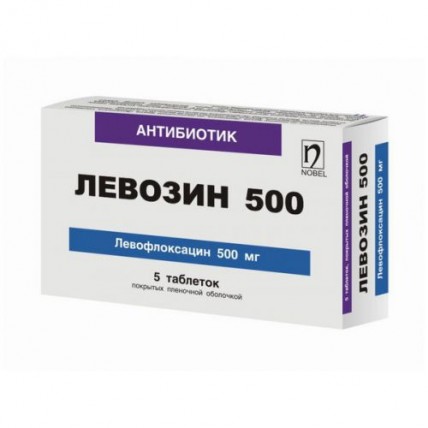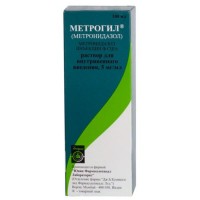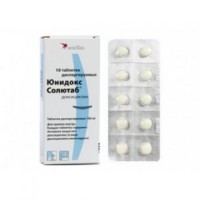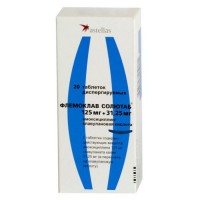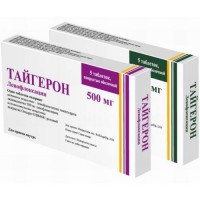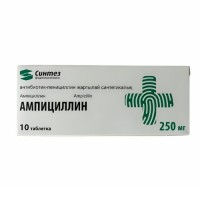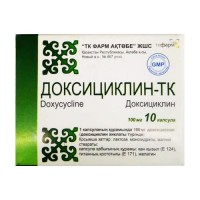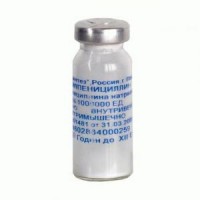Levozin 500 mg (5 tablets)
- $30.40
The instruction for medical use of LEVOZIN 250 medicine LEVOZIN 500 of LEVOZIN 750 the Trade name of LEVOZIN 250 of LEVOZIN 500 of LEVOZIN 750 the International unlicensed name Levofloxacin Dosage Form of the Tablet, film coated, 250 mg, 500 mg, 750 mg Structure One tablet contains active agent - a levofloksatsin of the gemigidrat of 256.23 mg (it is equivalent to a levofloksatsin of 250 mg), a levofloksatsin of the gemigidrat of 512.46 mg (it is equivalent to a levofloksatsin of 500 mg) or a levofloksatsin of the gemigidrat of 768.69 mg (it is equivalent to a levofloksatsin of 750 mg), excipients: cellulose microcrystalline PH 102, a hydroksipropilmetiltsellyuloza (pharmakoat 603 W), krospovidon (kollidon), sodium stearit fumarating, the water purified. structure of a cover of Opadray of Y-1-7000 white: hydroksipropilmetiltsellyuloz (gipromelloz), titan dioxide (E171), polyethyleneglycol 400 (macrogoal 400). The description of the Tablet, film coated, white color, oblong shape and with risky on one party. Pharmacotherapeutic group Antibacterial drugs for system use. Antimicrobial drug – derivative a hinolona. Ftorkhinolona. Levofloxacin. The ATX J01MA12 code the Pharmacological Pharmacokinetics Absorption At properties oral administration levofloxacin is soaked up quickly and completely, peak concentration in plasma is reached during 1-2 h. The absolute bioavailability is 95 - 100%. Steady concentration of drug is reached during 48 h after reception according to the scheme in a dosage of 500 mg 1 or 2 times a day. Distribution About 30 - 40% of a levofloksatsin contacts protein of blood plasma. The average volume of distribution of a levofloksatsin is about 100 l after introduction in a dose of 500 mg. Penetration into fabrics and liquids of a body of Levofloksatsin is widely distributed in bodies and fabrics, but badly gets into cerebrospinal fluid. Biotransformation is Completely metabolized, forming dezmetil-levofloxacin and N-oxide levofloxacin. These metabolites contain also lt, 5% of a dose of drug and are allocated with urine. Removal After reception of a levofloksatsin inside is slowly brought out of plasma (elimination half-life (t/2 6 - 8 h). It is removed generally by kidneys (& gt, 85% of the entered dose). The general clearance after single introduction in a dose of 500 mg was 175 +/-29.2 ml/min. Special groups of patients Patients with a renal failure In a renal failure the drug removal by kidneys decreases, elimination half-life, as shown to the table increases. Pharmacokinetics in a renal failure after oral administration of a single dose of 500 mg. Clkp
& lt, 20 20 - 49 50 - 80 Clpoch.
of 13 26 57 t1/2
35 27 9 Patients of advanced age does not exist age differences in pharmacokinetics of a levofloksatsin, except connected with differences in clearance of creatinine. Sexual distinctions Are not present proofs that these sexual distinctions have the clinical importance. The pharmacodynamics Levofloxacin represents synthetic antibacterial drug of a class of ftorkhinolon, S (-) an enantiomer of racemic active agent of an ofloksatsin. The action mechanism Levofloksatsin affects the DNK-giraza complex and topoisomerase IV as antibacterial drug, a derivative hinolon. FK/FD ratio Bactericidal activity of a levofloksatsin depends on a ratio between the maximum concentration in serum (Cmax) and the minimum overwhelming concentration (MOC). The resistance mechanism Resistance is bought gradually by a website target mutation in type topoisomerases II, DNK-girazy and topoisomerases IV. Other mechanisms of resistance and outflow of substances from fabric can also affect susceptibility to a levofloksatsin. The cross resistance between levofloksatsiny and other ftorkhinolona is observed. Because of features of the mechanism of action, there is no cross resistance between levofloksatsiny and other antibacterial drugs. Levofloxacin is active concerning strains of microorganisms: - aerobic gram-positive microorganisms: Enterococcus faecalis, Staphylococcus aureus (Methicillinum - sensitive), Staphylococcus haemoliticus (Methicillinum - sensitive), Staphylococcus saprophyticus, Streptococcus pneumoniae (penicillin - resistant strains), Streptococcus pyogenes and Streptococci (groups C and G), Staphylococcus haemoliticus (Methicillinum - resistant), - aerobic gram-negative microorganisms: Enterobacter cloacae, Escherichia coli, Haemophilus influenzae (ampicillin - sensitive and resistant), Heamophilus parainfluenzae, Klebsiella pneumoniae, Klebsiella oxytoca, Legionella pneumophila, Moraxella catarrhalis 1b+/b-, Pasteurella multocida, Proteus vulgaris, Proteus mirabilis, Pseudomonas aeruginosa, Serratia marcescens, Salmonella species, Shigella species, Yersinia enterocolitica, other Enterobacter spp, Bordetella pertussis, Citrobacter spp, Acinetobacter spp, Morganella morganii, and Providencia spp., - anaerobic microorganisms: Clostridium perfringes, Bacteroides fragilis, Peptostreptococci, other Bacteroides spp., Clostridium difficile, - intracellular microorganisms: Chlamidia pneumoniae, Chlamidia psittaci, Mycoplasma pneumoniae, Mycobacterium tuberculosis. Indications - acute bacterial sinusitis - exacerbation of chronic bronchitis - community-acquired pneumonia - the complicated infections of skin and soft tissues - pyelonephritis and the complicated infections of urinary tract - chronic bacterial prostatitis the Route of administration and doses the Adult: a pill is taken inside by 1 or 2 times a day. The dosage depends on type, weight of an infection and sensitivity of the activator. The maximum single dose – 500 mg, the maximum daily dose – 1000 mg. From normal or moderately reduced function of kidneys the clearance of creatine (CC) & gt, 50 ml/min. it is possible to recommend the following mode of dosing: The indication to use the Daily dose (depending on disease severity) treatment Duration (depending on disease severity) Acute bacterial sinusitis of 500 mg of 1 times a day 10 - 14 days Exacerbation of chronic bronchitis of bacterial 500 mg of 1 times a day 7 - 10 days Community-acquired pneumonia of 500 mg 1 or 2 times in days of 750 mg of 1 times a day 7 - 14 days 5 days Pyelonephritis of 500 mg of 1 times a day 7 - 10 days the Complicated infections of urinary tract of 750 mg of 1 times a day 7 - 10 days Uncomplicated cystitis of 250 mg of 1 times a day 3 days Chronic bacterial prostatitis of 500 mg of 1 times a day 28 days the Complicated infections of skin and soft tissues of 500 mg 1 or 2 times in day of 750 mg of 1 times a day 7 - 14 days 7 - 10 days Special groups of patients At a renal failure (clearance of creatinine ≤ 50 ml/min.) the Mode of dosing of 250 mg / 24 h 500 mg / 24 h 500 mg / 12 h Clearance of creatinine the First dose: 250 mg the First dose: 500 mg the First dose: 500 mg 50-20 ml/min. Then: on 125 mg / 24 h Then: on 250 mg / 24 h Then: on 250 mg / 12 h 19-10 ml/min. Then: on 125 mg / 48 h Then: on 125 mg / 24 h Then: on 125 mg / 12 h & lt, 10 ml/min. (including a hemodialysis and PAPD) 1 Then: on 125 mg / 48 h Then: on 125 mg / 24 h Then: on 125 mg / 24 h 1 After a hemodialysis or the continuous out-patient peritoneal dialysis (COPPD) the introduction of additional doses of drug is not required. The abnormal liver function is not required dose adjustment as levofloxacin is metabolized in insignificant degree in a liver and is generally removed by kidneys. Patients of advanced age dose adjustment of drug is not required from patients of advanced age, except the kidneys tied with function. Patients of children's age Drug is contraindicated to use for children and teenagers. The route of administration of the Tablet should be swallowed entirely, without chewing and washing down with enough liquid. At selection of doses of a tablet it is possible to pull down on the dividing line. The drug can be taken at meal time and between meals. The dividing line on a tablet allows to adjust a dose for patients with a renal failure. Unused drug should be utilized as appropriate according to local nature protection rules. Side effects Often (≥1/100, & lt, 1/10) - insomnia, a headache, dizziness - nausea, vomiting, diarrhea - increase in level of liver enzymes (ALT/nuclear heating plant, etc.). Infrequently (≥1/1000, & lt, 1/100) - a fungal infection, including Candida infection - resistance of a pathogen - a leukopenia, an eosinophilia - anorexia - concern - a condition of confusion of consciousness, hyperexcitability - drowsiness, a tremor, a dysgeusia - vertigo - an asthma - an abdominal pain, dyspepsia, a meteorism, a constipation - increase in level of bilirubin in blood - rash, an itching, urticaria, a hyperhidrosis - an arthralgia, myalgia - increase in level of creatinine in blood - an asthenia Seldom (≥1/10000, & lt, 1/1000) - thrombocytopenia, a neutropenia - a Quincke's disease, hypersensitivity - the hypoglycemia, at patients with diabetes is psychotic reactions with hallucinations and paranoia - a depression, agitation - unusual dreams, nightmares - convulsions - paresthesia - a disorder of vision, such as illegibility - tinnitus - tachycardia, heartbeat - hypotension - diseases of sinews, including a tendinitis (Achilles tendon) - muscle weakness, patients have a myasthenia gravis - an acute renal failure - the pyrexia Frequency is unknown - a pancytopenia, an agranulocytosis, hemolytic anemia - an acute anaphylaxis and anaphylactoid reactions even after introduction of the first dose of drug - a hyperglycemia - a hypoglycemia - mental disorders with the behavior constituting danger to the patient including suicide thinking or attempt of a suicide - peripheral touch and sensomotor neuropathy - a parosmiya including an anosmia - dyskinesia - extrapyramidal disorder - an ageusia - a faint - benign intracranial hypertensia - temporary loss of sight - disturbance or a hearing loss - ventricular tachycardia which can lead to cardiac arrest. - ventricular arrhythmia and torsade de pointes of ventricles (it is observed at patients on the ECG it is fixed lengthening of an interval of QT) - a bronchospasm, an allergic pneumonitis - hemorrhagic diarrhea, in rare instances a coloenteritis, including pseudomembranous colitis, pancreatitis - jaundice and heavy injury of a liver, including an acute liver failure with a lethal outcome, at patients with heavy hepatitis are a toxic epidermal necrolysis (Stephens-Johnson's syndrome), a polymorphic erythema, reaction of a photosensitization, a leykotsitoklastichesky vasculitis, stomatitis - a rhabdomyolysis, a rupture of sinews (Achilles tendon), ligaments, muscles - arthritis - pain (in a back, a breast and extremities) Other undesirable effects which are connected with use of ftorkhinolon, include porphyria attacks at patients with this disease of the Contraindication - hypersensitivity to hinolona, a levofloksatsin, excipients - epilepsy and other damages of central nervous system with the lowered convulsive threshold - chronic kidney disease with KK & lt, 50 ml/min. - the diseases of sinews connected with use of hinolon in the anamnesis - children's and teenage age up to 18 years - pregnancy - the lactation period Medicinal interactions the Tablet it is necessary to take Action of other medicines not less than for 2 h to or in 2 h after intake of salts of iron, zinc, the antiacid drugs containing magnesium or aluminum, or a didanozin (only dosage forms of a didanozin containing buffer substances with compounds of aluminum or magnesium. And also purpose of the sukralfat as at the same time decrease in absorption of drug can be observed if the patient needs to accept sukralfat and Levozin, then first of all accept sukralfat, in 2 hours it is possible to accept Levozin in tablets. Salts of calcium do not break absorption at oral administration. Theophylline and non-steroidal anti-inflammatory drugs decrease in a convulsive threshold at joint purpose of hinolon with theophylline, non-steroidal anti-inflammatory drugs is possible. Fenbufen increases concentration of a levofloksatsin by 13%. The concomitant use with glucocorticosteroids increases risk of a rupture of sinews. Probenetsid and Tsimetidin Levofloxacin should be applied carefully with drugs probenetsid and Cimetidinum, especially at patients with renal failures. The renal clearance decreased Cimetidinum (24%), probenetsid (34%). Other important information Clinical trials showed that use with calcium carbonate, digoxin, glibenclamide, ranitidine had no clinically significant impact on pharmacokinetics of a levofloksatsin. Effect of drug on other medicines Cyclosporine Elimination half-life of cyclosporine increased by 33% at use with levofloksatsiny. Antagonists of vitamin K of Increase in indicators of coagulative tests (PV/MNO) and/or developing of bleeding at patients, at use of a levofloksatsin and the antagonist of vitamin K (warfarin), it is necessary to carry out monitoring of results of coagulative tests. The medicines causing lengthening of an interval of QT Ftorkhinolonov should be applied carefully with antiarrhythmic drugs of the class IA and III, tricyclic antidepressants, macroleads and neuroleptics. In researches of pharmacokinetic interactions levofloxacin did not affect theophylline pharmacokinetics (marker CYP1A2 substrate), thereby is not CYP1A2 inhibitor. Other types of interaction Food the Drug in tablets can be taken irrespective of meal. The special instructions Considering that Methicillinum - resistant golden staphylococcus is resistant to ftorkhinolona, levofloxacin are not recommended to be applied in the infections caused Methicillinum - resistant staphylococcus. Levofloxacin can be applied at treatment of acute bacterial sinusitis and exacerbation of chronic bronchitis. When assigning it is recommended to consider resistance of E. coli to ftorkhinolona. Inhalation anthrax: use for the person is based on in vitro of data on sensitivity of Bacillus anthracis, and these preclinical trials, in connection with limited amount of clinical data. Doctors should address the agreed national and/or international documents concerning treatment of anthrax. The tendinitis and a rupture of sinews In rare instances develops a tendinitis which can lead to a rupture of a sinew. Often the Achilles tendon during 48 h after an initiation of treatment, or within several months after the treatment termination is surprised. Risk of developing a tendinitis and a rupture of sinews increases at patients 60 years and at 1000 mg accepting daily doses are more senior and also at reception of corticosteroids. At emergence of symptoms of a tendinitis it is necessary to see the attending physician and to stop reception of a levofloksatsin. The disease caused by Clostridium difficile Heavy, persistent diarrhea with blood impurity in time or after treatment levofloksatsiny can be a symptom of the disease caused by Clostridium difficile. The diseases caused by Clostridium difficile can vary on severity, a severe form is pseudomembranous colitis. At suspicion on Clostridium difficile, it is necessary to stop reception of a levofloksatsin and to begin the corresponding treatment. The patients predisposed to developing of spasms of Hinolona can reduce a threshold of convulsive readiness and provoke spasms. Levozin is contraindicated to the patients having epilepsy in the anamnesis or accepting the medicines reducing a threshold of convulsive readiness. In case of developing of convulsive spasms it is necessary to stop treatment. Patients with insufficiency glyukozo-6-fosfatdegidrogenazy At the patients having the hidden, obvious disturbances of activity glyukozo-6-fosfatdegidrogenazy the predisposition to hemolytic reactions can be observed. At use of a levofloksatsin for such patients perhaps hemolysis emergence. Patients with a renal failure Levofloxacin is generally excreted by kidneys, with disturbance of their function it is necessary to adjust a dose. Reactions of hypersensitivity Levofloxacin can cause the Quincke's disease and an acute anaphylaxis arising even after introduction of the first dose. It is necessary to stop immediately treatment and to contact the emergency doctor for rendering the appropriate emergency aid. Heavy bullous reactions At use of drug can heavy violent skin reactions (Stephens-Johnson's syndrome) or a toxic epidermal necrolysis. At emergence of reactions on skin / mucous membranes immediately to contact the doctor. The dysglycemia At use of hinolon is observed to treason
iya glucose content in blood (hypo-and a hyperglycemia) at patients with diabetes. There is a case of a hypoglycemic coma, it is recommended to watch glucose level. Prevention of a photosensitization At use of a levofloksatsin arises a photosensitization. For prevention of a photosensitization it is not recommended to be affected by solar, artificial UF of radiation, during treatment and during 48 h after the termination. The patients undergoing treatment using antagonists of vitamin K. Because of possible increase in indicators of coagulative tests and/or developing of bleeding it is necessary to carry out monitoring of coagulative tests at patients. Psychotic reactions It was reported about cases of emergence of psychotic reactions at the patients receiving hinolona including levofloxacin. Seldom or never after single dose of a levofloksatsin, reactions before the emergence of suicide thoughts and behavior constituting danger to the patient progressed. In case of similar reactions it is necessary to stop reception of a levofloksatsin and to take the appropriate measures. Levofloxacin should be applied with care at patients with psychosis or in the presence of psychiatric diseases in the anamnesis. Lengthening of an interval of QT of Ftorkhinolona, it is necessary to apply with care at patients who have risk factors of lengthening of an interval of QT: - a congenital syndrome of lengthening of an interval of QT - use of the drugs causing lengthening of an interval of QT (antiarrhythmic - the class IA and III, tricyclic antidepressants, macroleads, neuroleptics) - disturbance of balance of electrolytes (hypopotassemia, a hypomagnesiemia) - heart failure, a myocardial infarction, bradycardia. Advanced age and women are more sensitive to the drugs causing lengthening of an interval of QT. Therefore, levofloxacin needs to be applied with care at these groups of patients. Peripheral neuropathy It was reported about developing of peripheral touch neuropathy and peripheral sensomotor neuropathy which could develop pretty fast. At emergence of symptoms of neuropathy it is necessary to stop use of a levofloksatsin. Disturbances from a liver and biliary tract It was reported about liver necrosis cases to a liver failure with a lethal outcome, at patients with a serious basic disease as sepsis. Patients are recommended to stop treatment, to contact the doctor at emergence of symptoms of a disease of a liver (anorexia, jaundice, dark urine, an itching and morbidity of a stomach). Aggravation of a myasthenia gravis Ftorkhinolona, including levofloxacin, have the neuromuscular blocking activity and can strengthen muscle weakness, suffering from a myasthenia gravis. It is not recommended to apply levofloxacin in the presence at the patient in the anamnesis of a myasthenia gravis. Disorders of vision At disorders of vision or manifestation of influence of administration of drug on eyes it is necessary to address the ophthalmologist immediately. Superinfection, for a long time, can lead Use of a levofloksatsin to the overgrowth of insensitive microorganisms. At superinfection during treatment it is necessary to take the appropriate measures. Influence on results of laboratory researches using a levofloksatsin, the analysis on definition of opiates in urine can yield false positive results. Can be required to confirm results of analyses with use of a specific method. Levofloxacin can suppress Mycobacterium tuberculosis and, be the cause of false-negative results of bacteriological diagnosis of tuberculosis. Pregnancy Exists limited amount of data on use for pregnant women. Preclinical trials did not reveal direct and indirect harmful effects in terms of reproductive toxicity. The lack of clinical data and also experimental data confirm risk of injury of cartilages to the growing organism. Pregnant women should not apply Ftorkhinolona. The period of a lactation Is contraindicated to women during breastfeeding. There is not enough information concerning discharge of a levofloksatsin with breast milk, however other ftorkhinolona are allocated with breast milk. Lack of clinical data and also as experimental data confirm risk of injury of cartilages, it is not necessary to apply to women during breastfeeding. Features of influence of medicine on ability to run the vehicle or potentially dangerous mechanisms Undesirable effects (dizziness / vertigo, drowsiness, disorders of vision) can worsen ability to concentrate attention, to reduce reaction (control of motor transport or work with the equipment). Overdose Symptoms: nausea, erosive gastrointestinal tract diseases, dizziness, consciousness disturbances, attacks of spasms. Treatment: there is no specific antidote, drug withdrawal, gastric lavage, symptomatic therapy, dialysis is inefficient. The form of release and packing On 5 or 7 tablets film coated place in blister strip packaging from a film of polyvinylchloride and printing aluminum foil. On the 1 or 2 blister strip packaging together with the instruction for medical use in the state and Russian languages place in a pack cardboard with the hologram of manufacturing firm. To Store storage conditions in the dry, protected from light place, at a temperature not above 25 °C. To store out of children's reach! 4 years not to apply a period of storage after an expiration date. Prescription status According to the prescription the Producer/packer of JSC Nobel Almatinskaya Pharmatsevticheskaya Fabrika Republic of Kazakhstan Almaty, Shevchenko St. 162 E. Holder of the registration certificate of JSC Nobel Almatinskaya Pharmatsevticheskaya Fabrika Republic of Kazakhstan Almaty, Shevchenko St. 162 E. The address of the organization accepting in the territory of the Republic of Kazakhstan claims from consumers on quality of products (goods) and responsible for post-registration observation of safety of medicine: JSC Nobel Almatinskaya Pharmatsevticheskaya Fabrika Republic of Kazakhstan, Almaty, Shevchenko St. 162 E. Phone number: (+7 727) 399-50-50
To develop
& lt, 20 20 - 49 50 - 80 Clpoch.
of 13 26 57 t1/2
35 27 9 Patients of advanced age does not exist age differences in pharmacokinetics of a levofloksatsin, except connected with differences in clearance of creatinine. Sexual distinctions Are not present proofs that these sexual distinctions have the clinical importance. The pharmacodynamics Levofloxacin represents synthetic antibacterial drug of a class of ftorkhinolon, S (-) an enantiomer of racemic active agent of an ofloksatsin. The action mechanism Levofloksatsin affects the DNK-giraza complex and topoisomerase IV as antibacterial drug, a derivative hinolon. FK/FD ratio Bactericidal activity of a levofloksatsin depends on a ratio between the maximum concentration in serum (Cmax) and the minimum overwhelming concentration (MOC). The resistance mechanism Resistance is bought gradually by a website target mutation in type topoisomerases II, DNK-girazy and topoisomerases IV. Other mechanisms of resistance and outflow of substances from fabric can also affect susceptibility to a levofloksatsin. The cross resistance between levofloksatsiny and other ftorkhinolona is observed. Because of features of the mechanism of action, there is no cross resistance between levofloksatsiny and other antibacterial drugs. Levofloxacin is active concerning strains of microorganisms: - aerobic gram-positive microorganisms: Enterococcus faecalis, Staphylococcus aureus (Methicillinum - sensitive), Staphylococcus haemoliticus (Methicillinum - sensitive), Staphylococcus saprophyticus, Streptococcus pneumoniae (penicillin - resistant strains), Streptococcus pyogenes and Streptococci (groups C and G), Staphylococcus haemoliticus (Methicillinum - resistant), - aerobic gram-negative microorganisms: Enterobacter cloacae, Escherichia coli, Haemophilus influenzae (ampicillin - sensitive and resistant), Heamophilus parainfluenzae, Klebsiella pneumoniae, Klebsiella oxytoca, Legionella pneumophila, Moraxella catarrhalis 1b+/b-, Pasteurella multocida, Proteus vulgaris, Proteus mirabilis, Pseudomonas aeruginosa, Serratia marcescens, Salmonella species, Shigella species, Yersinia enterocolitica, other Enterobacter spp, Bordetella pertussis, Citrobacter spp, Acinetobacter spp, Morganella morganii, and Providencia spp., - anaerobic microorganisms: Clostridium perfringes, Bacteroides fragilis, Peptostreptococci, other Bacteroides spp., Clostridium difficile, - intracellular microorganisms: Chlamidia pneumoniae, Chlamidia psittaci, Mycoplasma pneumoniae, Mycobacterium tuberculosis. Indications - acute bacterial sinusitis - exacerbation of chronic bronchitis - community-acquired pneumonia - the complicated infections of skin and soft tissues - pyelonephritis and the complicated infections of urinary tract - chronic bacterial prostatitis the Route of administration and doses the Adult: a pill is taken inside by 1 or 2 times a day. The dosage depends on type, weight of an infection and sensitivity of the activator. The maximum single dose – 500 mg, the maximum daily dose – 1000 mg. From normal or moderately reduced function of kidneys the clearance of creatine (CC) & gt, 50 ml/min. it is possible to recommend the following mode of dosing: The indication to use the Daily dose (depending on disease severity) treatment Duration (depending on disease severity) Acute bacterial sinusitis of 500 mg of 1 times a day 10 - 14 days Exacerbation of chronic bronchitis of bacterial 500 mg of 1 times a day 7 - 10 days Community-acquired pneumonia of 500 mg 1 or 2 times in days of 750 mg of 1 times a day 7 - 14 days 5 days Pyelonephritis of 500 mg of 1 times a day 7 - 10 days the Complicated infections of urinary tract of 750 mg of 1 times a day 7 - 10 days Uncomplicated cystitis of 250 mg of 1 times a day 3 days Chronic bacterial prostatitis of 500 mg of 1 times a day 28 days the Complicated infections of skin and soft tissues of 500 mg 1 or 2 times in day of 750 mg of 1 times a day 7 - 14 days 7 - 10 days Special groups of patients At a renal failure (clearance of creatinine ≤ 50 ml/min.) the Mode of dosing of 250 mg / 24 h 500 mg / 24 h 500 mg / 12 h Clearance of creatinine the First dose: 250 mg the First dose: 500 mg the First dose: 500 mg 50-20 ml/min. Then: on 125 mg / 24 h Then: on 250 mg / 24 h Then: on 250 mg / 12 h 19-10 ml/min. Then: on 125 mg / 48 h Then: on 125 mg / 24 h Then: on 125 mg / 12 h & lt, 10 ml/min. (including a hemodialysis and PAPD) 1 Then: on 125 mg / 48 h Then: on 125 mg / 24 h Then: on 125 mg / 24 h 1 After a hemodialysis or the continuous out-patient peritoneal dialysis (COPPD) the introduction of additional doses of drug is not required. The abnormal liver function is not required dose adjustment as levofloxacin is metabolized in insignificant degree in a liver and is generally removed by kidneys. Patients of advanced age dose adjustment of drug is not required from patients of advanced age, except the kidneys tied with function. Patients of children's age Drug is contraindicated to use for children and teenagers. The route of administration of the Tablet should be swallowed entirely, without chewing and washing down with enough liquid. At selection of doses of a tablet it is possible to pull down on the dividing line. The drug can be taken at meal time and between meals. The dividing line on a tablet allows to adjust a dose for patients with a renal failure. Unused drug should be utilized as appropriate according to local nature protection rules. Side effects Often (≥1/100, & lt, 1/10) - insomnia, a headache, dizziness - nausea, vomiting, diarrhea - increase in level of liver enzymes (ALT/nuclear heating plant, etc.). Infrequently (≥1/1000, & lt, 1/100) - a fungal infection, including Candida infection - resistance of a pathogen - a leukopenia, an eosinophilia - anorexia - concern - a condition of confusion of consciousness, hyperexcitability - drowsiness, a tremor, a dysgeusia - vertigo - an asthma - an abdominal pain, dyspepsia, a meteorism, a constipation - increase in level of bilirubin in blood - rash, an itching, urticaria, a hyperhidrosis - an arthralgia, myalgia - increase in level of creatinine in blood - an asthenia Seldom (≥1/10000, & lt, 1/1000) - thrombocytopenia, a neutropenia - a Quincke's disease, hypersensitivity - the hypoglycemia, at patients with diabetes is psychotic reactions with hallucinations and paranoia - a depression, agitation - unusual dreams, nightmares - convulsions - paresthesia - a disorder of vision, such as illegibility - tinnitus - tachycardia, heartbeat - hypotension - diseases of sinews, including a tendinitis (Achilles tendon) - muscle weakness, patients have a myasthenia gravis - an acute renal failure - the pyrexia Frequency is unknown - a pancytopenia, an agranulocytosis, hemolytic anemia - an acute anaphylaxis and anaphylactoid reactions even after introduction of the first dose of drug - a hyperglycemia - a hypoglycemia - mental disorders with the behavior constituting danger to the patient including suicide thinking or attempt of a suicide - peripheral touch and sensomotor neuropathy - a parosmiya including an anosmia - dyskinesia - extrapyramidal disorder - an ageusia - a faint - benign intracranial hypertensia - temporary loss of sight - disturbance or a hearing loss - ventricular tachycardia which can lead to cardiac arrest. - ventricular arrhythmia and torsade de pointes of ventricles (it is observed at patients on the ECG it is fixed lengthening of an interval of QT) - a bronchospasm, an allergic pneumonitis - hemorrhagic diarrhea, in rare instances a coloenteritis, including pseudomembranous colitis, pancreatitis - jaundice and heavy injury of a liver, including an acute liver failure with a lethal outcome, at patients with heavy hepatitis are a toxic epidermal necrolysis (Stephens-Johnson's syndrome), a polymorphic erythema, reaction of a photosensitization, a leykotsitoklastichesky vasculitis, stomatitis - a rhabdomyolysis, a rupture of sinews (Achilles tendon), ligaments, muscles - arthritis - pain (in a back, a breast and extremities) Other undesirable effects which are connected with use of ftorkhinolon, include porphyria attacks at patients with this disease of the Contraindication - hypersensitivity to hinolona, a levofloksatsin, excipients - epilepsy and other damages of central nervous system with the lowered convulsive threshold - chronic kidney disease with KK & lt, 50 ml/min. - the diseases of sinews connected with use of hinolon in the anamnesis - children's and teenage age up to 18 years - pregnancy - the lactation period Medicinal interactions the Tablet it is necessary to take Action of other medicines not less than for 2 h to or in 2 h after intake of salts of iron, zinc, the antiacid drugs containing magnesium or aluminum, or a didanozin (only dosage forms of a didanozin containing buffer substances with compounds of aluminum or magnesium. And also purpose of the sukralfat as at the same time decrease in absorption of drug can be observed if the patient needs to accept sukralfat and Levozin, then first of all accept sukralfat, in 2 hours it is possible to accept Levozin in tablets. Salts of calcium do not break absorption at oral administration. Theophylline and non-steroidal anti-inflammatory drugs decrease in a convulsive threshold at joint purpose of hinolon with theophylline, non-steroidal anti-inflammatory drugs is possible. Fenbufen increases concentration of a levofloksatsin by 13%. The concomitant use with glucocorticosteroids increases risk of a rupture of sinews. Probenetsid and Tsimetidin Levofloxacin should be applied carefully with drugs probenetsid and Cimetidinum, especially at patients with renal failures. The renal clearance decreased Cimetidinum (24%), probenetsid (34%). Other important information Clinical trials showed that use with calcium carbonate, digoxin, glibenclamide, ranitidine had no clinically significant impact on pharmacokinetics of a levofloksatsin. Effect of drug on other medicines Cyclosporine Elimination half-life of cyclosporine increased by 33% at use with levofloksatsiny. Antagonists of vitamin K of Increase in indicators of coagulative tests (PV/MNO) and/or developing of bleeding at patients, at use of a levofloksatsin and the antagonist of vitamin K (warfarin), it is necessary to carry out monitoring of results of coagulative tests. The medicines causing lengthening of an interval of QT Ftorkhinolonov should be applied carefully with antiarrhythmic drugs of the class IA and III, tricyclic antidepressants, macroleads and neuroleptics. In researches of pharmacokinetic interactions levofloxacin did not affect theophylline pharmacokinetics (marker CYP1A2 substrate), thereby is not CYP1A2 inhibitor. Other types of interaction Food the Drug in tablets can be taken irrespective of meal. The special instructions Considering that Methicillinum - resistant golden staphylococcus is resistant to ftorkhinolona, levofloxacin are not recommended to be applied in the infections caused Methicillinum - resistant staphylococcus. Levofloxacin can be applied at treatment of acute bacterial sinusitis and exacerbation of chronic bronchitis. When assigning it is recommended to consider resistance of E. coli to ftorkhinolona. Inhalation anthrax: use for the person is based on in vitro of data on sensitivity of Bacillus anthracis, and these preclinical trials, in connection with limited amount of clinical data. Doctors should address the agreed national and/or international documents concerning treatment of anthrax. The tendinitis and a rupture of sinews In rare instances develops a tendinitis which can lead to a rupture of a sinew. Often the Achilles tendon during 48 h after an initiation of treatment, or within several months after the treatment termination is surprised. Risk of developing a tendinitis and a rupture of sinews increases at patients 60 years and at 1000 mg accepting daily doses are more senior and also at reception of corticosteroids. At emergence of symptoms of a tendinitis it is necessary to see the attending physician and to stop reception of a levofloksatsin. The disease caused by Clostridium difficile Heavy, persistent diarrhea with blood impurity in time or after treatment levofloksatsiny can be a symptom of the disease caused by Clostridium difficile. The diseases caused by Clostridium difficile can vary on severity, a severe form is pseudomembranous colitis. At suspicion on Clostridium difficile, it is necessary to stop reception of a levofloksatsin and to begin the corresponding treatment. The patients predisposed to developing of spasms of Hinolona can reduce a threshold of convulsive readiness and provoke spasms. Levozin is contraindicated to the patients having epilepsy in the anamnesis or accepting the medicines reducing a threshold of convulsive readiness. In case of developing of convulsive spasms it is necessary to stop treatment. Patients with insufficiency glyukozo-6-fosfatdegidrogenazy At the patients having the hidden, obvious disturbances of activity glyukozo-6-fosfatdegidrogenazy the predisposition to hemolytic reactions can be observed. At use of a levofloksatsin for such patients perhaps hemolysis emergence. Patients with a renal failure Levofloxacin is generally excreted by kidneys, with disturbance of their function it is necessary to adjust a dose. Reactions of hypersensitivity Levofloxacin can cause the Quincke's disease and an acute anaphylaxis arising even after introduction of the first dose. It is necessary to stop immediately treatment and to contact the emergency doctor for rendering the appropriate emergency aid. Heavy bullous reactions At use of drug can heavy violent skin reactions (Stephens-Johnson's syndrome) or a toxic epidermal necrolysis. At emergence of reactions on skin / mucous membranes immediately to contact the doctor. The dysglycemia At use of hinolon is observed to treason
iya glucose content in blood (hypo-and a hyperglycemia) at patients with diabetes. There is a case of a hypoglycemic coma, it is recommended to watch glucose level. Prevention of a photosensitization At use of a levofloksatsin arises a photosensitization. For prevention of a photosensitization it is not recommended to be affected by solar, artificial UF of radiation, during treatment and during 48 h after the termination. The patients undergoing treatment using antagonists of vitamin K. Because of possible increase in indicators of coagulative tests and/or developing of bleeding it is necessary to carry out monitoring of coagulative tests at patients. Psychotic reactions It was reported about cases of emergence of psychotic reactions at the patients receiving hinolona including levofloxacin. Seldom or never after single dose of a levofloksatsin, reactions before the emergence of suicide thoughts and behavior constituting danger to the patient progressed. In case of similar reactions it is necessary to stop reception of a levofloksatsin and to take the appropriate measures. Levofloxacin should be applied with care at patients with psychosis or in the presence of psychiatric diseases in the anamnesis. Lengthening of an interval of QT of Ftorkhinolona, it is necessary to apply with care at patients who have risk factors of lengthening of an interval of QT: - a congenital syndrome of lengthening of an interval of QT - use of the drugs causing lengthening of an interval of QT (antiarrhythmic - the class IA and III, tricyclic antidepressants, macroleads, neuroleptics) - disturbance of balance of electrolytes (hypopotassemia, a hypomagnesiemia) - heart failure, a myocardial infarction, bradycardia. Advanced age and women are more sensitive to the drugs causing lengthening of an interval of QT. Therefore, levofloxacin needs to be applied with care at these groups of patients. Peripheral neuropathy It was reported about developing of peripheral touch neuropathy and peripheral sensomotor neuropathy which could develop pretty fast. At emergence of symptoms of neuropathy it is necessary to stop use of a levofloksatsin. Disturbances from a liver and biliary tract It was reported about liver necrosis cases to a liver failure with a lethal outcome, at patients with a serious basic disease as sepsis. Patients are recommended to stop treatment, to contact the doctor at emergence of symptoms of a disease of a liver (anorexia, jaundice, dark urine, an itching and morbidity of a stomach). Aggravation of a myasthenia gravis Ftorkhinolona, including levofloxacin, have the neuromuscular blocking activity and can strengthen muscle weakness, suffering from a myasthenia gravis. It is not recommended to apply levofloxacin in the presence at the patient in the anamnesis of a myasthenia gravis. Disorders of vision At disorders of vision or manifestation of influence of administration of drug on eyes it is necessary to address the ophthalmologist immediately. Superinfection, for a long time, can lead Use of a levofloksatsin to the overgrowth of insensitive microorganisms. At superinfection during treatment it is necessary to take the appropriate measures. Influence on results of laboratory researches using a levofloksatsin, the analysis on definition of opiates in urine can yield false positive results. Can be required to confirm results of analyses with use of a specific method. Levofloxacin can suppress Mycobacterium tuberculosis and, be the cause of false-negative results of bacteriological diagnosis of tuberculosis. Pregnancy Exists limited amount of data on use for pregnant women. Preclinical trials did not reveal direct and indirect harmful effects in terms of reproductive toxicity. The lack of clinical data and also experimental data confirm risk of injury of cartilages to the growing organism. Pregnant women should not apply Ftorkhinolona. The period of a lactation Is contraindicated to women during breastfeeding. There is not enough information concerning discharge of a levofloksatsin with breast milk, however other ftorkhinolona are allocated with breast milk. Lack of clinical data and also as experimental data confirm risk of injury of cartilages, it is not necessary to apply to women during breastfeeding. Features of influence of medicine on ability to run the vehicle or potentially dangerous mechanisms Undesirable effects (dizziness / vertigo, drowsiness, disorders of vision) can worsen ability to concentrate attention, to reduce reaction (control of motor transport or work with the equipment). Overdose Symptoms: nausea, erosive gastrointestinal tract diseases, dizziness, consciousness disturbances, attacks of spasms. Treatment: there is no specific antidote, drug withdrawal, gastric lavage, symptomatic therapy, dialysis is inefficient. The form of release and packing On 5 or 7 tablets film coated place in blister strip packaging from a film of polyvinylchloride and printing aluminum foil. On the 1 or 2 blister strip packaging together with the instruction for medical use in the state and Russian languages place in a pack cardboard with the hologram of manufacturing firm. To Store storage conditions in the dry, protected from light place, at a temperature not above 25 °C. To store out of children's reach! 4 years not to apply a period of storage after an expiration date. Prescription status According to the prescription the Producer/packer of JSC Nobel Almatinskaya Pharmatsevticheskaya Fabrika Republic of Kazakhstan Almaty, Shevchenko St. 162 E. Holder of the registration certificate of JSC Nobel Almatinskaya Pharmatsevticheskaya Fabrika Republic of Kazakhstan Almaty, Shevchenko St. 162 E. The address of the organization accepting in the territory of the Republic of Kazakhstan claims from consumers on quality of products (goods) and responsible for post-registration observation of safety of medicine: JSC Nobel Almatinskaya Pharmatsevticheskaya Fabrika Republic of Kazakhstan, Almaty, Shevchenko St. 162 E. Phone number: (+7 727) 399-50-50
To develop
